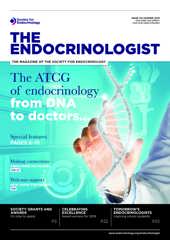As a young researcher, I find studying rare genetic conditions both rewarding and challenging. In the EU, a disease is defined as rare if it affects fewer than one in 2000 people,1 with the majority of cases thought to be of genetic origin.
The most prevalent monogenetic disorder is cystic fibrosis. It is caused by a mutation in the cystic fibrosis transmembrane conductance regulator (CFTR) gene and affects mainly the lungs, but also other organs, such as the pancreas, liver, kidneys and intestines. The condition affects one in 3000 newborns,2 which equates to 226 new patients in England and Wales every year.3 This life-threatening condition is common enough and severe enough for many countries to have implemented screening in maternity wards.
Most conditions, however, are much rarer than that. Personally, I work on disorders related to calcium homeostasis, and here prevalence as low as one in 13,000 individuals4 has been reported.
THE RESEARCH CONUNDRUM
Even though the individual conditions are rare, the chance of having a rare disease is nevertheless quite high. According to estimates by the National Institutes for Health Research (NIHR), rare diseases could affect as many as 10% of the population. Here, we have a conundrum: on the one hand, we want to help the millions of patients living with these rare conditions; on the other hand, it is not lucrative for funding bodies and pharmaceutical companies to invest resources in this area, because the cost of developing a treatment for a rare disease is no cheaper than for a prevalent one.
This problem has partly been addressed by the Orphan Drug Act 1983, offering financial and regulatory incentives to companies developing and selling such treatments. However, the return on investment will still be much lower than for common conditions.
UNDERSTANDING THE UNDERLYING BIOLOGY
Even where there is the incentive to find novel treatments, we first need to understand the underlying biology. The publication of the human genome in 2003 transformed the field of genetic research. However, investigation of rare genetic diseases has proved especially difficult. Traditionally, it is based on family studies. In theory, the recipe is simple: take a kindred with an inherited disease, identify mutations that are unique to affected family members as opposed to unaffected ones and show that there is a functional change in a suitable in vitro system.
In practice, this requires access to an entire family’s medical history and patient samples, which in the modern world often involves co-ordination between several hospitals in different parts of the country. Within any single family, thousands of genetic mutations are shared. Even when comparing multiple affected versus unaffected family members, we still find ourselves with dozens (or if we are unlucky, hundreds) of candidate genes, each of which has to be painstakingly tested. We therefore normally require a large number of patients from multiple families for the study. With a rare condition, it can be impossible to obtain sufficient samples to achieve a scientifically rigorous conclusion.
A more modern approach is to use large scale sequencing databases that link genetic variants to phenotype data (such as the UK Biobank). However, genome-wide association studies (GWAS) have limitations for rare diseases, because screening thousands of genes in very few patients is likely to yield false-positive results. To obtain statistical power, GWAS rely on large sample sizes, which are only available for common diseases. Additionally, these databases are often retrospective observations rather than prospective studies, which means that data and diagnosis can be missing and/or unreliable, and family history is often not available.
OPPORTUNITIES FOR TREATMENT
Despite these challenges, there have been success stories with direct patient benefit. One of the big opportunities for the treatment of rare diseases is drug repurposing, which is a lot more cost-effective than developing a drug from scratch. In some cases, existing indications can be extended to rare diseases. For example, our research group identified a novel GNA11 mutation in a patient with familial hypocalciuric hypercalcaemia type 2 and showed impairment of the calcium-sensing-receptor (CaSR) signalling pathway in vitro. In collaboration with Helsinki University Hospital, Finland, the patient was treated with cinacalcet, a positive allosteric modulator of CaSR, which is approved for the treatment of secondary hyperparathyroidism, caused by end-stage renal disease. As a result, the patient became normocalcaemic.
Another interesting approach is to make use of the many compounds that have been shown to be safe for use in humans, but failed in clinical trials because they were not effective enough for the indication for which they were tested. For example, the calcilytic ronacaleret failed in a phase II study because of lack of efficacy in postmenopausal women with osteoporosis. It has recently been shown to rectify impaired glucose tolerance in a mouse model for inherited hyperglycaemia, making it a potential candidate for the treatment of genetic forms of diabetes.
Gene therapy is currently a last resort treatment for certain cancer types. Looking to the future, it is certainly a promising therapeutic approach for genetic diseases. However, germline mutations occur in every single cell of our body and targeting therapies to specific tissues will be a challenge.
In conclusion, researching rare diseases is crucial for millions of patients worldwide. Without the incentives for pharmaceutical companies to investigate treatments, it falls mainly to universities and research labs to identify the genetic mutations responsible, and to propose new treatments. This not only benefits the patients, but also advances our understanding of the underlying biology. Moreover, with an increasing number of companies offering DNA self-testing, we need to educate and inform the public about the work we do to differentiate between benign polymorphisms and disease-causing mutations.
Anna Gluck, PhD Student, Oxford Centre for Diabetes, Endocrinology and Metabolism, Radcliffe Department of Medicine, University of Oxford
REFERENCES
- European Commission 2008. Communication on rare diseases: Europe’s challenges.
- O’Sullivan BP & Freedman SD 2009 Lancet 373 1891–1904.
- Haines N 2018 Births in England and Wales: 2017. Office for National Statistics.
- Gorvin CM et al. 2018. Human Molecular Genetics 27 901–911.







